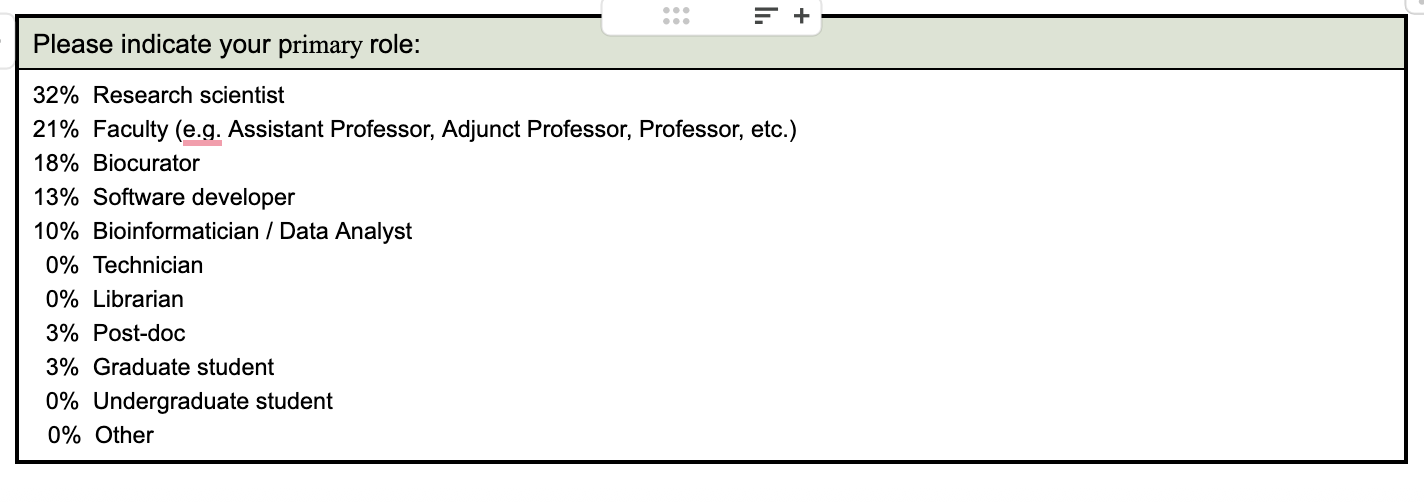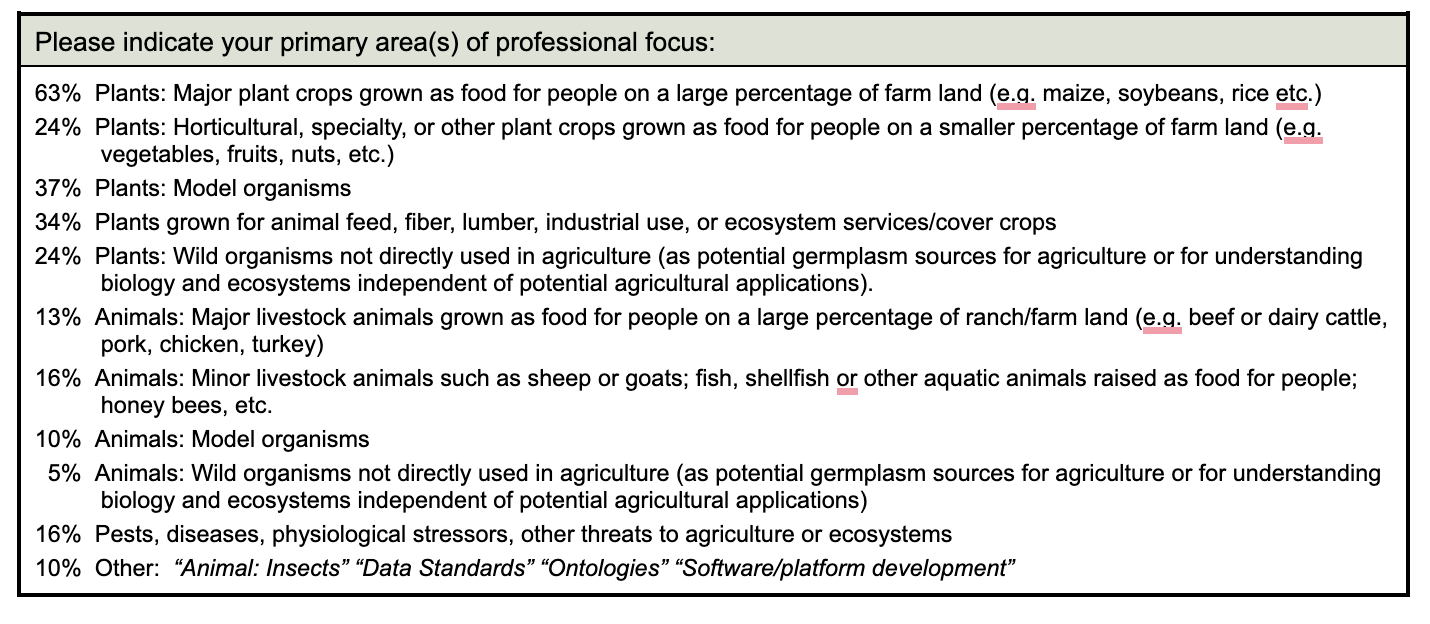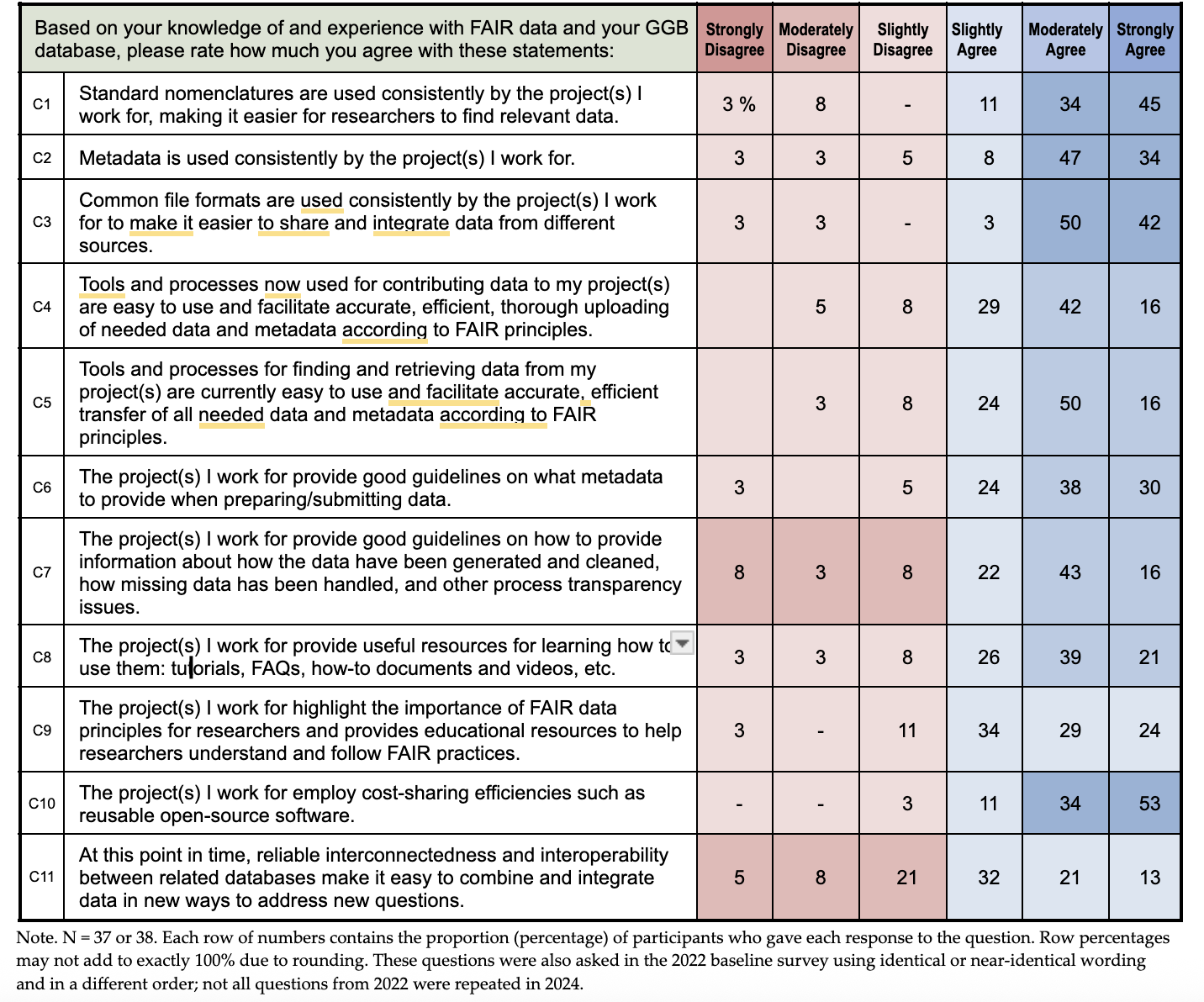2024 Survey of Genomic, Genetic, and Breeding (GGB) Database Team Members
In partnership with Michael Coe (Washington State University)
In Year 3 of our NSF RCN grant (Award Abstract # 2126334), the AgBioData Consortium, in partnership with Washington State University, surveyed database professionals on standardized data curation principles and their implementation in data repositories for agricultural research and breeding programs as a follow-up to a baseline survey run in Year 1 (see report here). This follow-up survey aimed to assess whether changes in the perception or understanding of FAIR data in our community have occurred during the NSF RCN grant.
Summary of Year 3 Survey Data
In total, we received 38 usable responses, which are summarized below. The full survey report is available here.
1. Survey Sample, Participant Characteristics, and Familiarity and Experience with GGB Databases
Over a quarter of respondents (26%) reported working in a university that offers related PhD degrees; 24% reported working in a Land Grant university; and 45% reported working for the US Department of Agriculture (Table 1). As displayed in Table 2, most reported their primary professional role as being a research scientist (32%), faculty member (21%), biocurator (18%), software developer (13%), bioinformatician/data analyst (10%), or postdoc/graduate student (6%).
Most respondents reported a professional focus on plants, including major plant crops (63%), model organisms (37%), horticultural specialty crops (24%), plants grown for purposes besides human consumption (34%), and wild organisms not directly used in agriculture (24%; Table 3). Animals were a primary focus for fewer respondents, including major livestock animals (13% of respondents), minor livestock animals (16%), model organisms (10%), and wild organisms not directly used in agriculture (5%).
Table 1. Organizational Affiliations of 2024 Survey Respondents

Table 2. Primary Professional Role of 2024 Survey Respondents

Table 3. Professional Focus of 2024 Survey Respondents

2024 Ratings and Recommendations On FAIR Data Practices in GGB Databases and Resources
GGB database or resource team members were asked to rate their agreement with statements about their experiences, observations, and opinions regarding the current status of FAIR data practices in GGB databases (Table 5). They were also asked to rate priorities for future development of FAIR data practices in these projects and to provide related comments and recommendations (Table 6). Below, we summarize the differences between the 2022 and 2024 survey periods, even if some of these differences might be due to sampling errors.
- Maintenance of consistent data practices. 2024 ratings for standard nomenclatures, metadata, and common file formats ranged from 79% to 92% of respondents “strongly” or “moderately” agreeing that their projects apply these practices consistently. In 2022, baseline survey participants gave lower ratings to their projects (59% to 76%) for these questions.
- User-friendliness of data system tools for contributing and finding/retrieving data. In 2024, ratings for ease of contributing FAIR and accurate data and ease of finding and retrieving data showed 58% and 66% of respondents “strongly” or “moderately” agreeing that their projects provide this for users. In 2022, baseline survey participants gave comparable ratings to their projects for data contribution (59%) and lower ratings for ease of data retrieval (55%).
- Perceptions of the extent to which the GGB databases provide good guidelines for users on some key FAIR data practices. Regarding metadata and data process transparency, 68% of respondents “strongly” or “moderately” agreed that “The project(s) I work for provide good guidelines on what metadata to provide when preparing/submitting data” and 59% of respondents “strongly” or “moderately” agreed that “The project(s) I work for provide good guidelines on how to provide information about how the data have been generated and cleaned, how missing data has been handled, and other process transparency issues.” In 2022, baseline survey participants gave lower ratings to their projects (54% and 37% respectively) for these two questions.
- Education of data system users. In 2024, 60% of respondents “strongly” or “moderately” agreed that “the project(s) I work for provide useful resources for learning how to use them: tutorials, FAQs, how-to documents and videos, etc.” The corresponding ratings from the 2022 survey sample were 76%, indicating that the 2024 sample was less likely to report that their project provided helpful educational resources for users. In 2024, 53% of respondents “strongly” or “moderately” agreed that ”the project(s) I work for highlight the importance of FAIR data principles for researchers and provide educational resources to help researchers understand and follow FAIR practices.” The corresponding figure from the 2022 survey sample was 44%.
- Implementation of cost-sharing efficiencies. 87% of 2024 respondents “strongly” or “moderately” agreed that their project employs “cost-sharing efficiencies such as reusable open-source software.” Similar ratings (84%) were reported in 2022.
As in 2022, the 2024 sample gave relatively high ratings to the use of cost-sharing efficiencies such as open-source software, the consistent use of standard nomenclatures, and the use of common file formats. Relatively low ratings were given for documentation of how the data has been generated and cleaned, how missing data has been handled, and other process transparency issues, along with interconnectedness and interoperability between related databases.
Table 5. 2024 Appraisal of the Status of FAIR Data Implementation in GGB Databases

2024 Priorities for Further Development of FAIR Data Practices in GGB Databases
Survey participants were asked to rate the importance of three potential priorities for improved data curation (Table 6). All three were rated as being “very important” or “highest priority” by more than half of the respondents. As in 2022, the highest ratings were given to the application of community standards by publishers and enforcement of data submission requirements,” which was rated as “highest priority” by 54 % of 2024 respondents and as “a very important priority” by another 43% of respondents. In 2024, “Timely and up-to-date availability of curated data” was rated as being “very important” or “highest priority” by 84% of respondents. “Professional incentives from funders” was rated as being “very important” or “highest priority” by 73% of respondents. Corresponding figures from 2022 were similar (79% and 67%), indicating a sustained need for further development in these areas.
Table 6. 2024 Priorities for Further Development of FAIR Data Practices in GGB Databases

